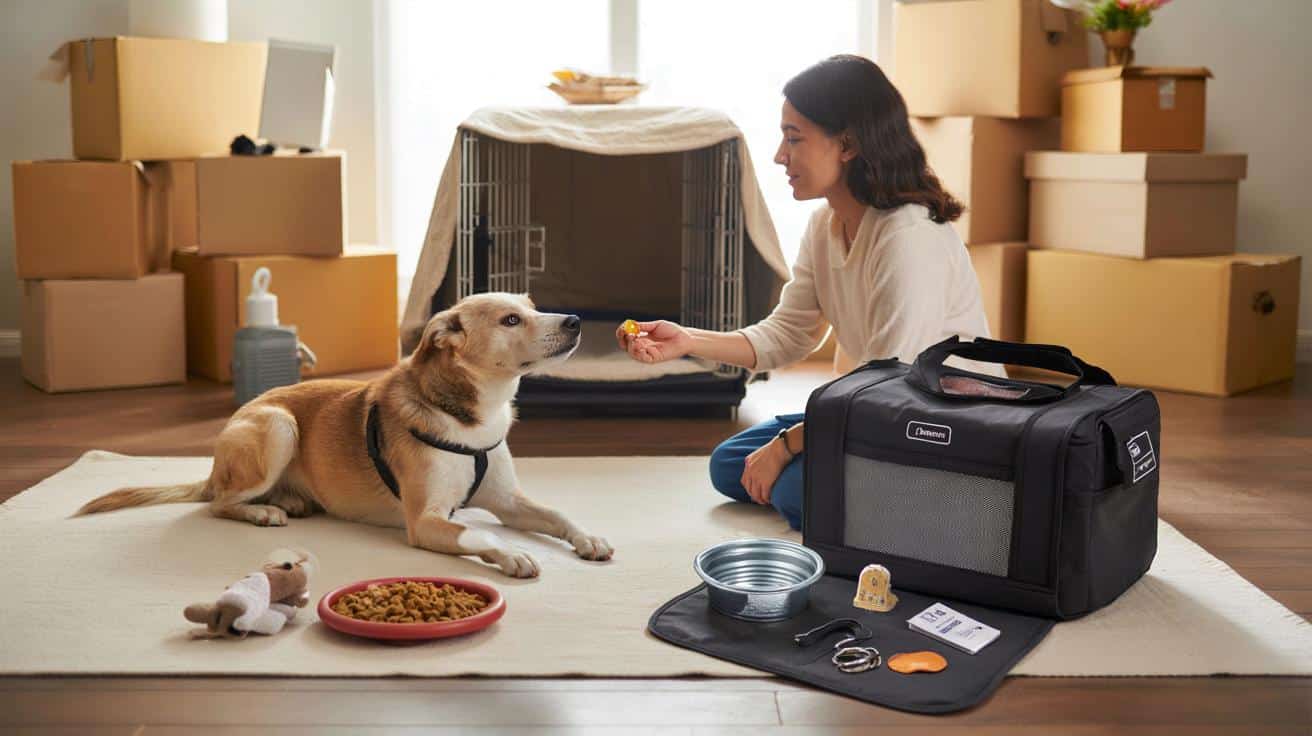A house move rattles routines and nudges nerves on both ends of the lead.
Your dog reads change faster than you tape boxes. Scents fade, furniture shifts, doors open and shut. Give structure before the chaos, and you spare yourself barking, puddles and the heart-thump of a sudden escape.
What your dog experiences when you move
Dogs map their world through smell, repetition and familiar routes. When the sofa vanishes and corridors echo, their internal compass wobbles. That can trigger barking, whining, panting, clinginess, pacing, chewing or toileting slips. None of this signals defiance. It is a safety response to a landscape that no longer makes sense.
Think “predictable, not perfect”: small, steady signals of normality beat grand gestures once panic has started.
Your role is to keep what anchors your dog: time, scent, safe spaces and controllable choices. That starts weeks, not hours, before the van arrives.
Seven steps that calm the chaos
Start three weeks out with small changes
Stage boxes in one room so the whole home does not morph overnight. Feed a few treats on and around a closed box each day. Rotate one or two items of furniture first, then pause. If you can, visit the new area for short walks at quiet times so fresh smells become less startling.
Place a worn T‑shirt or your dog’s blanket inside the first packed boxes; you will unpack familiar scent on day one.
Protect routines to the minute
Dogs flourish when clocks stay steady. Aim to hold mealtimes, walk slots and bedtime within a narrow window.
- Keep meals within 15 minutes of the usual time.
- Walk at the same hour, even if the route shortens.
- Bring back a simple training game (sit, touch, find‑it) for two minutes, twice a day.
Pack a canine go-bag
A single grab bag prevents frantic rummaging when the kettle and the kibble part company.
- Food for five days, measuring scoop, water, collapsible bowl.
- Lead, collar with up-to-date tag, long line, spare poo bags.
- Bed or crate mat, two favourite toys, chew, old blanket with strong odour of “home”.
- Medication, vet records, microchip number, recent photo.
- Pheromone diffuser or spray, towel, enzymatic cleaner for accidents.
Create a safe room on moving day
Before any lifting starts, set up a closed, quiet space. Use a sign on the door. Ask helpers to keep it shut. Put the bed, water and a stuffed chew inside. Many dogs relax better in a familiar crate; drape a light cover for a den-like feel.
“Do not open — dog inside.” A scrap of paper on the door can prevent a dash to the street.
Travel without drama
Secure your dog in the car with a crash-tested crate or a certified harness. Open windows slightly for fresh air, not enough for a jump. Offer a light meal at least three hours before departure to reduce motion sickness. If your dog gets carsick, speak to your vet about anti-nausea options and training short, calm car sessions ahead of time. Avoid sedation unless your vet directs it for specific medical reasons.
Set up home base first
In the new place, carry your dog straight to a quiet room. Lay the bed, unbox the blanket, and plug in a pheromone diffuser. Scatter a small handful of kibble on the mat so the first sniff equals reward. Let your dog explore one room at a time, then invite a rest. Walk the garden on lead while you check gaps under gates and loose fence panels.
Walk, water, settle, then explore. This order cuts overarousal and keeps toilet rhythms on track.
Re-teach toilet habits kindly
Fresh floors invite experiments. Treat the first week like a puppy refresher. Go out after meals, naps and play. Praise outside toileting warmly. If an accident happens, clean with an enzymatic product and move on. Scolding sets back confidence.
Three mistakes that cost you time, money and trust
- Sending away familiar kit too early. Keep the bed, bowls and comfort toys with you until the last load.
- Letting doors stand open. One missed latch can trigger a lost-dog search.
- Changing everything at once. New food, new timetable and new house in one weekend overwhelms even easygoing dogs.
Your 10-day transition plan at a glance
| Day | Action |
|---|---|
| −10 to −7 | Stage two boxes; feed near them; short training bursts; confirm microchip details and ID tag. |
| −6 to −3 | Pack non-essentials; walk at quiet hours; visit new streets if possible; prepare the go-bag. |
| −2 to 0 | Safe room ready; signs on doors; keep meals/walks on schedule; calm, chew-based downtime. |
| Move day | Safe room closed; secured car travel; unpack bed and bowls first; short sniff walk on lead. |
| +1 to +3 | One-room explorations; toilet breaks after sleep/meals; gentle games; check garden barriers twice. |
| +4 to +10 | Expand access; keep routine tight; add new walks slowly; note stress signs and adjust pace. |
Cold-weather moves: small adjustments, big peace of mind
Short daylight and slick pavements change the equation. Book walks during daylight where you can. Use a reflective collar or clip-on light. For thin-coated breeds, a snug coat helps on windswept pavements. Warm the car before loading, then crack the window once moving. Dry paws after rain to avoid slips on smooth floors.
Accident prevention that actually works
House-proud meets dog-centred when you control access and scent. Baby gates give you air without escape risk. Keep boxes off the floor in rooms your dog roams to reduce chewing temptation. If marking starts, restrict access, clean thoroughly, and increase quiet sniff walks to drain tension. Many dogs settle faster when they rip up a “legal” cardboard box under your eye.
Manage, don’t plead: doors, gates and leads do more than repeated “leave it”.
Health, legal and admin you might miss
Update microchip address the week you move. Order a fresh tag with your new postcode and a reachable phone number. Register with a local vet before you need one. If you rent, photograph the property on arrival and agree pet wear-and-tear rules in writing; it protects your deposit. Check local by-laws on leads, dog-control orders and park times; norms can change street to street.
If your dog is anxious by nature, book a pre-move call with a qualified behaviourist. A simple plan—easy scent games, sniff-based walks, and a chew strategy—cuts barking and pacing. Pet insurance sometimes includes helplines; read your policy benefits so you use what you already pay for.
If stress spikes, use a reset
Stress stacks like boxes. When you see clinginess, lip licking, yawning, or refusal to settle, run a reset: a five-minute sniff walk on a quiet street, a scatter of kibble on a towel, then a darkened room and a chew. Turn music on low. Delay visitors for 48 hours. Most dogs rebound when the environment stops shouting at them.
Extra ideas that strengthen the bond during a move
Try a scent trail indoors: dab a tiny smear of peanut butter on three chair legs and let your dog follow the trail to a jackpot on the bed. One minute, big payoff. Build a “place” cue on the new mat, paying one treat for one quiet breath while lying down. Run a three-day “find your box” game where your dog targets the box that smells like your old blanket; it turns boxes from stress to puzzle.
Budget a small safety pot for contingencies: spare lead, gate latch, extra enzymatic cleaner and replacement tag. The spend is low, the savings high. If you own a large garden, walk the perimeter together twice daily for the first week. That slow patrol helps your dog redraw their mental map and reduces patrolling barks at night.








